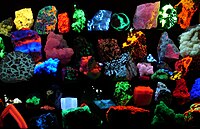
Photo from wikipedia
Two three-dimensional (3-D) polycyanidometallate-based luminescent thermometers with the general formula {Ln4Co4(CN)24(4-benpyo)17(H2O)·7H2O}n Ln = (Dy(III)(1), Eu(III)(2)), based on the red-emissive diamagnetic linker [Co(CN)6]3- and the bulky pyridine derivative that possesses the… Click to show full abstract
Two three-dimensional (3-D) polycyanidometallate-based luminescent thermometers with the general formula {Ln4Co4(CN)24(4-benpyo)17(H2O)·7H2O}n Ln = (Dy(III)(1), Eu(III)(2)), based on the red-emissive diamagnetic linker [Co(CN)6]3- and the bulky pyridine derivative that possesses the N-oxide moiety, 4-benzyloxy-pyridine N-oxide (benpyo), were prepared for the first time. The structure of compound 1 has been determined by single-crystal X-ray crystallography while the purity and structure of 2 have been confirmed by CHN, Fourier transform infrared spectroscopy (FT-IR), and powder X-ray diffraction (PXRD) analysis. Magnetic AC susceptibility measurements at zero field show no single-molecule magnet (SMM) behavior indicating fast relaxation operating in 1. Upon application of an optimal field of 2 kOe, the SMM character of compound 1 is revealed while the τ(Τ) can be reproduced solely considering the Raman process τ-1 = CTn with C = 7.0901(3) s-1 K-n and n = 3.58(1), indicating that a high density of low-lying states and optical as well as acoustic phonons play a major role in the relaxation mechanism. Micron-sized superconducting quantum interference device (μ-SQUID) loops show a very narrow opening in agreement with the AC susceptibility studies and complete active space self-consistent field (CASSCF) calculations. The interaction operating between the Dy(III) ions was quantified from CASSCF calculations. Good agreement is found by fitting the experimental DC χMΤ(Τ) and M(H), employing the Lines model, with JLines = -0.087 cm-1 (-0.125 K). The excitation spectra of compound 2 are used for temperature sensing in the 25-325 nm range with a maximum relative thermal sensitivity, Sr = 0.6% K-1 at 325 K, whereas compound 1 operates as a luminescent thermometer based on its emission features in the temperature range of 16-350 K with Sr ≈ 2.3% K-1 at 240 K.
Journal Title: Inorganic chemistry
Year Published: 2022
Link to full text (if available)
Share on Social Media: Sign Up to like & get
recommendations!